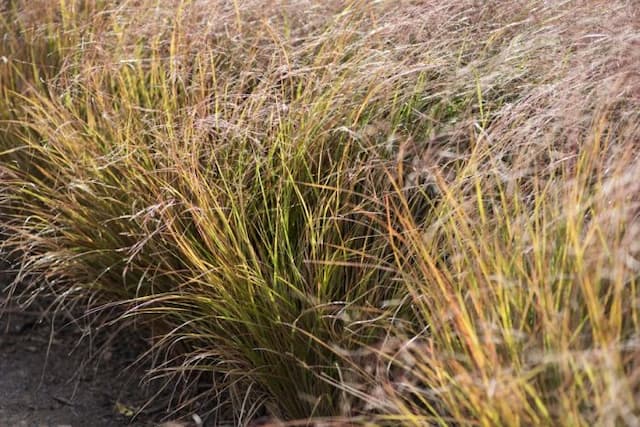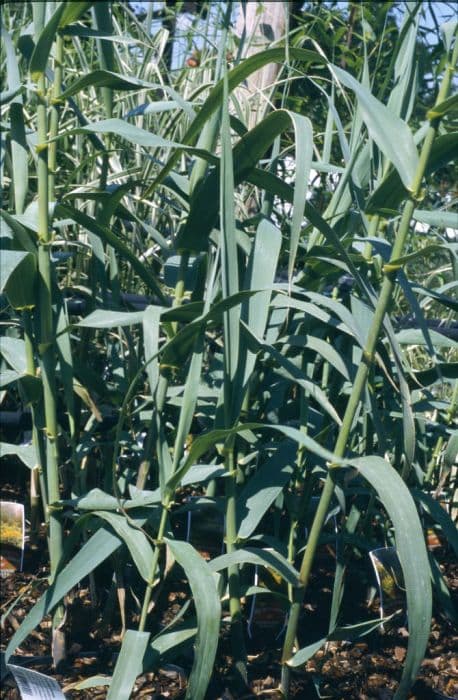Variegated Giant Reed Arundo donax var. versicolor (v)











ABOUT
Arundo donax var. versicolor, often referred to as variegated giant reed, is a visually striking plant. The foliage is the most distinctive aspect of its appearance, with leaves featuring a combination of creamy white and green stripes that run longitudinally along their length. This variegation brings an eye-catching contrast of color to each blade, giving it a unique pattern that can create a vibrant visual impact in any setting it adorns. The leaves themselves are long and narrow, tapering to a point. They arch gracefully from the main stems, creating an elegant and somewhat flowing form. This suggests movement, as if the leaves are gently swaying even without a breeze. The variegated giant reed produces feathery flowering plumes, which emerge later in the growing season. These plumes contribute further to the ornamental quality of the plant. Their color can vary, often starting with a purplish tint and maturing to a soft, beige hue as the season progresses. The stems of the plant are stout and have a resemblance to bamboo, supporting the weight of the heavy foliage and flower heads. These stems are coated in a rough surface that can range in color but typically holds a greenish to yellowish tone, providing a stark background that makes the striped leaves even more pronounced. Overall, the variegated giant reed's appearance is quite robust, with a dense clumping habit that adds a lush texture to its surroundings. Its variegated leaves are the most noteworthy aspect, delivering a decorative aesthetic that can light up gardens or natural landscapes where it is planted.
About this plant
 Names
NamesFamily
Poaceae
Synonyms
Variegated Giant Reed, Striped Giant Reed
Common names
Arundo donax var. versicolor.
 Toxicity
ToxicityTo humans
The most common name for Arundo donax var. versicolor is "variegated giant reed." To my knowledge, as of the last update, variegated giant reed is not typically considered toxic to humans. However, it’s important always to be cautious with plant handling and ingestion, as individual sensitivities can vary. Ingesting any part of a plant that is not commonly regarded as edible, including the variegated giant reed, could potentially cause gastrointestinal discomfort or allergic reactions in sensitive individuals. If accidental ingestion occurs or if any adverse reactions are observed, it is advisable to consult with a medical professional.
To pets
The most common name for Arundo donax var. versicolor is "variegated giant reed." As of the last update, there is no specific known toxicity of variegated giant reed to pets such as dogs and cats. Nonetheless, it is generally recommended to prevent pets from ingesting plants that are not a normal part of their diet, as they could potentially cause gastrointestinal upset or other adverse reactions. If you believe your pet has ingested variegated giant reed and is showing signs of distress, consult with a veterinarian.
 Characteristics
CharacteristicsLife cycle
Perennials
Foliage type
Deciduous
Color of leaves
Variegated
Height
10 feet (3 meters)
Spread
5 feet (1.5 meters)
Plant type
Grass
Hardiness zones
7
Native area
Mediterranean
Benefits
 General Benefits
General Benefits- Ornamental Value: Arundo donax 'Versicolor' adds aesthetic appeal to landscapes with its variegated foliage.
- Fast Growth: It grows quickly, providing rapid coverage or achieving a desired height in a relatively short amount of time.
- Soil Erosion Control: Its robust root system helps stabilize soil and control erosion along riverbanks, slopes, and other susceptible areas.
- Wildlife Habitat: It provides shelter and habitat for various species of birds and other wildlife.
- Privacy Screening: Due to its tall and dense growth, it can be used as a natural privacy screen in gardens and along property borders.
- Sound Barrier: The dense growth can also help to reduce noise pollution when planted along highways or busy streets.
- Low Maintenance: Once established, it requires minimal care, making it suitable for low-maintenance landscaping.
 Medical Properties
Medical PropertiesThis plant is not used for medical purposes.
 Air-purifying Qualities
Air-purifying QualitiesThis plant is not specifically known for air purifying qualities.
 Other Uses
Other Uses- Biological pest control: Arundo donax, commonly known as giant reed, can be used as a habitat to support predator insects for controlling agricultural pests.
- Windbreaks and erosion control: The dense growth of giant reed makes it suitable for planting as windbreaks or for stabilizing soils to prevent erosion.
- Acoustic insulation: The thick culms of the plant can be processed into materials that provide acoustic insulation for buildings and structures.
- Ornamental use: With its variegated foliage, the giant reed can be planted as an attractive feature in gardens and landscapes for aesthetic purposes.
- Craft material: The canes of the giant reed are strong and flexible, making them a useful resource for crafting musical instruments like reeds for woodwinds or even as material for handmade furniture.
- Fodder: In some regions, the leaves and younger stems are used as fodder for livestock, especially where other forage crops might not thrive.
- Biomass fuel: Arundo donax can be harvested for use as a biomass fuel, providing an alternative energy source for heating or electricity generation.
- Phytoremediation: The giant reed can absorb heavy metals and other contaminants from the soil, thus being used for cleaning polluted lands or water bodies.
- Carbon sequestration: Due to its rapid growth rate, Arundo donax can be planted to sequester carbon and help mitigate greenhouse gas emissions.
- Wastewater treatment: The plant has been investigated for use in constructed wetlands for treating agricultural or municipal wastewater through its ability to uptake nutrients and pollutants.
Interesting Facts
 Feng Shui
Feng ShuiThe Giant Reed is not used in Feng Shui practice.
 Zodiac Sign Compitability
Zodiac Sign CompitabilityThe Giant Reed is not used in astrology practice.
 Plant Symbolism
Plant Symbolism- Growth: Arundo donax, commonly known as giant reed, often symbolizes rapid and robust growth, reflecting its own fast-growing nature in the wild.
- Flexibility: As a reed, it represents flexibility and resilience, bending with the wind but not breaking.
- Invasiveness: Due to its invasive tendencies, giant reed can symbolize domination or unchecked expansion in various aspects of life.
- Adaptability: The plant's ability to thrive in various conditions signifies adaptability and the capacity to survive in changing environments.
 Water
WaterVariegated Giant Reed requires regular watering, particularly during dry spells. It prefers consistently moist soil, so ensure it gets water at least once a week, with more frequent watering during particularly hot or dry periods. Depending on the weather, you might need to provide around 1 to 2 inches of water either through rainfall or manual watering per week. Use a soaker hose to water the base of the plant to keep the moisture level even. Be careful not to overwater, as this can lead to root rot, especially if the soil does not drain well.
 Light
LightVariegated Giant Reed thrives in full sun to partial shade. It prefers a location where it receives direct sunlight for at least six hours a day. An ideal spot would be one that offers morning sunlight and some afternoon shade, especially in regions with very intense afternoon sun.
 Temperature
TemperatureVariegated Giant Reed is quite hardy and can tolerate a wide range of temperatures. It can survive minimum temperatures down to about 20 degrees Fahrenheit but thrives in temperatures between 60 and 90 degrees Fahrenheit. Avoid exposure to temperatures below 20 degrees Fahrenheit for extended periods to prevent frost damage.
 Pruning
PruningPruning Variegated Giant Reed helps to control its size and encourage healthy growth. It should be cut back to the ground in late winter or early spring before new growth begins. This allows the plant to put energy into producing fresh, vibrant shoots. Remove any dead or damaged canes as needed throughout the year to maintain plant health.
 Cleaning
CleaningAs needed
 Soil
SoilFor variegated giant reed (Arundo donax 'Variegata'), the best soil mix is one that is rich, moist, and well-draining. A mixture of garden soil, compost, and sand or perlite in equal parts is ideal. This plant prefers a soil pH range of 6.0 to 7.5.
 Repotting
RepottingVariegated giant reed (Arundo donax 'Variegata') typically does not need frequent repotting as it can thrive even in somewhat crowded conditions. Repot every 2 to 3 years or when the plant becomes noticeably pot-bound or the growth seems to slow down.
 Humidity & Misting
Humidity & MistingVariegated giant reed (Arundo donax 'Variegata') is not particularly sensitive to humidity levels. It can adapt to a wide range of atmospheric moisture conditions but thrives in an environment with average to high humidity.
 Suitable locations
Suitable locationsIndoor
Use bright, indirect light and ample space.
Outdoor
Full sun, spacious area, protect from strong winds.
Hardiness zone
7-10 USDA
 Life cycle
Life cycleThe life of Arundo donax var. versicolor, commonly known as variegated giant reed, begins with seed germination, which requires warm temperatures and moist soil to initiate. Once germinated, the seedlings establish themselves quickly, growing into tall, robust, perennial grasses with variegated foliage. The plant reaches maturity and enters its vegetative stage, during which it can spread aggressively through rhizomes, forming dense thickets. Annual growth adds height and girth to the plant, reaching up to several meters tall. After reaching maturity, the giant reed produces feathery plumes of flowers in the late summer, although it rarely sets viable seed in non-native habitats. Eventually, the plant's life ends, either from environmental stress, disease, or eradication efforts due to its invasiveness, but the rhizomes can remain dormant for a period, ready to sprout again.
 Propogation
PropogationPropogation time
Spring-Early Summer
The most popular method of propagating Arundo donax var. versicolor, commonly known as Variegated Giant Reed, is through division. This is best done in spring, as the plant emerges from dormancy and begins to show new growth. To propagate by division, carefully dig up a mature clump of the reed, ensuring to get a good portion of the root system. Then, using a sharp spade or knife, divide the root mass into smaller sections, each with several growing points or shoots. These divisions should be replanted immediately at the same soil depth they were originally growing, and watered thoroughly to help establish the new plants. Each division should be spaced about 3 to 6 feet apart to allow adequate room for growth. In metric measurements, the spacing would range from approximately 0.9 to 1.8 meters apart.









